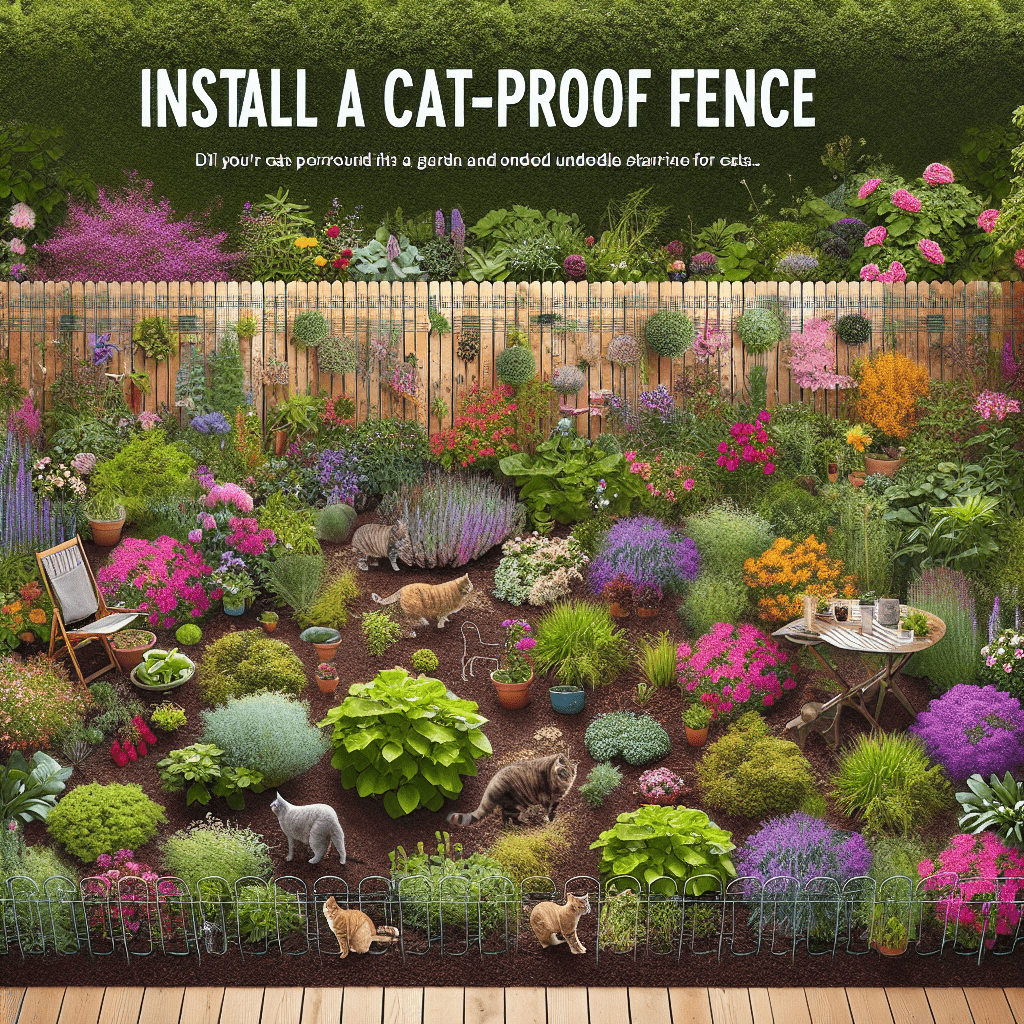Gardening is a relaxing and fulfilling hobby. But suppose you’re a gardener with feline friends. In that case, you may have found yourself between maintaining your pristine mulch beds and keeping your cats happy. Cats often find mulch irresistible, leading to digging, toileting, and potentially damaging your beloved plants. But don’t worry—there are ways to create a cat-proof garden without sacrificing your greenery or upsetting your furry friends.
Table of Contents
Understanding the Problem
Why Cats Are Attracted to Mulch
Cats are naturally curious creatures, and mulch presents an attractive playground. The texture of mulch provides a soft and comfortable surface for them to walk on, dig into, and even nap. Additionally, some types of mulch, particularly those made from organic materials, emit scents that cats find appealing. This combination of texture and smell can make your mulch beds irresistible to your feline companions.
The Impact of Cats on Mulch
When cats make your mulch beds their hangout, it’s trouble in paradise. They dig around, messing up the neat look of your mulch and harming your plants’ roots. Worse, they might treat it like their bathroom, leaving a mess and possibly spreading nasty bacteria and parasites in your garden. Over time, this can mess with your plants’ health and looks.

Solutions for Keeping Cats Out of Mulch
Safe and Humane Deterrents
One of the most effective ways to keep cats out of your mulch is to use safe and humane deterrents. There are several options available, both natural and commercial:
- Natural Deterrents:
- Citrus Peels: Did you know cats aren’t fans of citrus smells? Oranges, lemons, limes – you name it. Scattering some citrus peels where you don’t want cats hanging around can help keep them at bay.
- Coffee Grounds: Did you know that the strong smell of coffee grounds can keep cats away? Just sprinkle some used coffee grounds around your garden or flower beds, and watch as cats think twice before stepping in.
- Vinegar: Cats don’t like the sharp, sour smell of vinegar. Mixing some vinegar with water and spraying it around the edges of places you want to keep cat-free works wonders.
- Herbs: Planting herbs such as lavender, rosemary, or rue can be natural repellents. These herbs have strong scents that cats find unpleasant, helping to keep them away from your garden or other areas.
- Commercial Deterrents:
- Sprays: Various commercial sprays are available specifically designed to deter cats. These sprays are typically made with ingredients that are unpleasant to cats but safe and non-toxic, ensuring no harm comes to the animals.
- Ultrasonic Devices: These devices emit high-frequency sounds that are unpleasant for cats but inaudible to humans. They can be placed outdoors to create a cat-free zone without disturbing people.
- Motion-Activated Sprinklers: These sprinklers are designed to activate when they detect motion, surprising cats with a burst of water. This harmless method effectively deters cats from entering specific areas, using their natural aversion to water to your advantage.
Altering the Garden Layout
Reconfiguring your garden layout can help discourage cats from entering your mulch beds:
- Physical Barriers:
- Place large, flat stones over the mulch. These stones create a surface that’s difficult for cats to dig into, making the area less appealing for their activity.
- Lay down chicken wire under the mulch. The wire’s texture is uncomfortable for cats’ paws, deterring them from walking or digging in the area.
- Put up some low fences around your mulch beds. They can look good and serve a purpose, acting like a no-entry sign for cats trying to get into the mulch.
- Add decorative rocks around the perimeter or within the mulch beds. These rocks can serve as obstacles that make navigation difficult for cats, discouraging their presence.
- Less Attractive Areas:
- Replace the mulch in certain areas with gravel or pebbles. These materials are less comfortable for cats to walk on and dig into, reducing the likelihood of choosing these spots.
- Use larger bark chips instead of fine mulch. Larger pieces are more complicated for cats to move and dig through, making the area less enticing.
- Consider planting densely in your mulch beds. Dense planting can create a natural barrier, reducing the open spaces where cats might be tempted to dig.
Implementing these strategies can create a garden environment that is less inviting for cats, helping to keep your mulch beds intact and free from unwanted guests.
Creating a Cat-Friendly Space
Another great tip? Set up a cat-friendly area in your garden.
- Set up a small sand or dirt area where your cats can dig and play. This gives them a natural outlet for their digging instincts and a space to enjoy themselves.
- Plant cat-friendly plants like catnip or cat grass to attract them to this designated space. Catnip has a natural appeal to most cats, and cat grass provides safe greenery for them to munch on.
- Consider adding cool vertical spaces like shelves, platforms, or even a tiny treehouse for your cats to climb and hang out on. Cats love checking things out from up high, so giving them these options will keep them entertained and happy. Mix it up and place those platforms at different heights to keep things interesting for them.

Keeping Mulch Areas Free of Cats
Regular Maintenance Tips
To make sure your cat deterrents keep doing their job, regular upkeep is critical:
- Refresh Natural Deterrents:
- Citrus Peels: Replace every few days to ensure the scent remains potent and continues to deter cats.
- Coffee Grounds: Spread fresh coffee grounds weekly as their smell fades.
- Vinegar: Reapply vinegar to surfaces or spray every few days to maintain its strong odor.
- Maintain Commercial Deterrents:
- Sprays and Granules: Adhere to the manufacturer’s guidelines for reapplication to ensure continuous effectiveness.
- Electronic Devices: Check batteries regularly and replace them as needed to ensure devices remain operational.
- Deterrent Mats: Inspect for wear and tear and replace mats if they show signs of significant damage.
- Inspect and Adjust Barriers:
- Fences and Netting: Regularly inspect for gaps, tears, or weaknesses and repair them promptly to prevent cats from breaching.
- Spikes and Prickly Strips: Ensure these remain securely fastened and clean of debris.
- Motion-Activated Devices: Test sensors frequently to ensure they are responsive and adjust their positions to cover vulnerable areas effectively.
Encouraging Positive Cat Behavior
Training and conditioning your cats to avoid the mulch can also be beneficial:
- Try giving your cats treats and praise when they hang out in their own space. It’s all about that positive reinforcement!
- If caught digging or toileting in the mulch, redirect your cats to their designated area.
- Skip the punishment—it freaks them out and could worsen things. It is better to stick with positive vibes and redirection to keep your cats clear of the mulch.
Conclusion
Creating a harmonious garden space that accommodates your love for plants and your feline friends is achievable with the right strategies. By understanding why cats are attracted to mulch and implementing safe and humane deterrents, you can protect your garden beds while keeping your cats happy. Regular maintenance and positive reinforcement will help ensure your efforts remain effective.
Remember, a pet-friendly garden doesn’t mean sacrificing beauty or functionality. You can create a space you and your cats can enjoy with creativity and effort. Consider booking a consultation with one of our gardening experts for personalized advice and tips on creating a cat-proof garden. We can create a garden that thrives harmoniously with your furry companions.
Frequently Asked Questions (FAQs)
Why do cats dig in mulch?
Cats may dig in mulch for several reasons, such as exploring their environment, looking for insects or small creatures, or using the mulch as a litter box. Mulch’s soft texture can be particularly appealing for digging behaviors.
Are natural deterrents safe for my garden plants?
Natural deterrents like citrus peels, coffee grounds, and vinegar are generally safe for garden plants. However, monitoring your plants for adverse reactions is always a good idea, mainly if you use these deterrents in large quantities.
How often should I refresh natural deterrents in my garden?
Natural deterrents should be refreshed regularly to maintain their effectiveness. For example, citrus peels and coffee grounds may need to be replaced every few days, depending on weather conditions and your garden’s level of cat activity.
Can I use commercial cat deterrents along with natural ones?
Absolutely! Combining both natural and commercial cat deterrents can be a highly effective strategy. For example, you can use a motion-activated sprinkler with lavender plants to maximize your efforts in keeping cats away from your mulch beds.
What should I do if my cat digs in the mulch despite using deterrents?
If your cat continues to dig in the mulch, reassess and strengthen your deterrents or try new ones. Altering your garden layout or creating a more attractive, cat-friendly space can also help. In persistent cases, consulting with a pet behavior expert may provide additional insights and solutions tailored to your cat’s specific behavior.
Sarah Smith is a passionate dog and cat enthusiast, blogger, and pet care expert. With years of experience researching and writing about various dog breeds cat breeds, she brings a wealth of knowledge and insight to her blog, PetPession.com. Sarah loves exploring the unique traits, histories, and care needs of different breeds, helping pet owners make informed decisions. Her mission is to create helpful, friendly, and well-researched content that both educates and celebrates the joy of pet ownership. When she’s not writing, Sarah enjoys outdoor adventures with her own furry friends.


1 thought on “How to Stop Cats from Digging in Your Mulch”